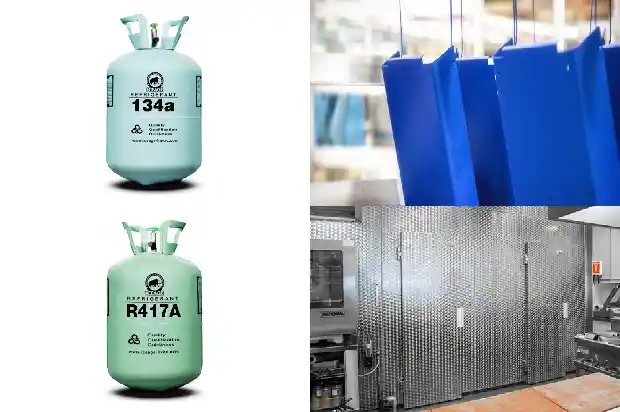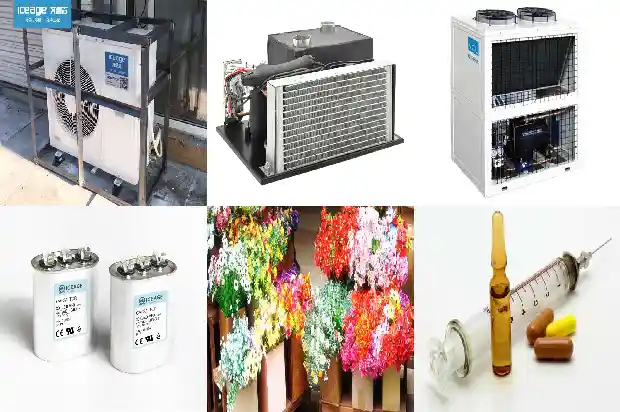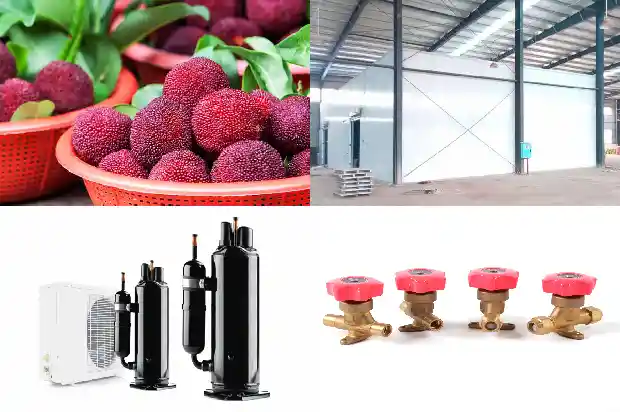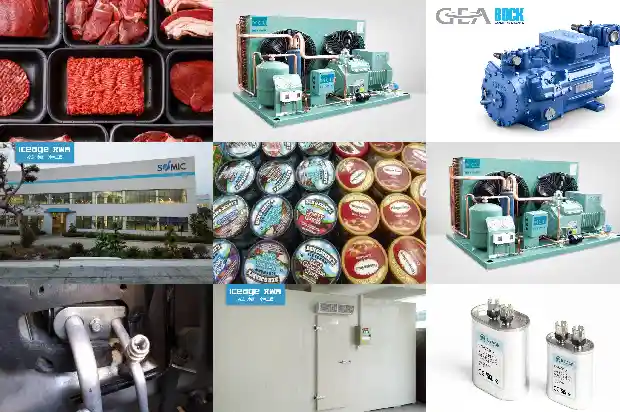Don't You Know These Four Aspects of Compressor Protection?
2025-04-15
I. Why Does the Compressor Need Protection?
When the compressor is running, some abnormal situations may occur, such as: too high exhaust pressure, too low suction pressure, insufficient oil pressure, overheating of the motor, excessive liquid entering the cylinder, etc. In the event of abnormal situations, without protection measures, the compressor will be damaged.
The protection measures taken for the compressor can be divided into four categories:
When the compressor is running, some abnormal situations may occur, such as: too high exhaust pressure, too low suction pressure, insufficient oil pressure, overheating of the motor, excessive liquid entering the cylinder, etc. In the event of abnormal situations, without protection measures, the compressor will be damaged.
The protection measures taken for the compressor can be divided into four categories:
- Prevention of liquid slugging;
- Pressure protection;
- Protection of the built-in motor;
- Temperature protection.
II. Prevention of Liquid Slugging
When too much liquid enters the cylinder and there is not enough time to discharge it from the exhaust valve, liquid slugging will occur in the cylinder. The very high pressure generated during liquid slugging will damage components such as the cylinder, piston, and connecting rod. Therefore, a series of protection measures need to be taken. - False Cover
Press the valve assembly tightly against the end of the cylinder with a spring to form a false cover. When the pressure in the cylinder is too high, the exhaust valve will be lifted up, the liquid will be discharged, and the pressure in the cylinder will drop rapidly. - Oil Heater
The lubricating oil in the crankcase dissolves the refrigerant, and the amount of dissolution increases when the ambient temperature is low. When the compressor starts, the pressure in the crankcase suddenly drops, a large amount of refrigerant vaporizes, the lubricating oil becomes foamy and is sucked into the cylinder, causing liquid slugging. Heating the lubricating oil with an oil heater before starting to reduce the amount of refrigerant dissolved in the lubricating oil is an effective measure to avoid liquid slugging. - Gas-Liquid Separator
The gas-liquid separator shown is also called a liquid receiver. The gas-liquid mixture from the evaporator is separated in the gas-liquid separator.
The gas enters from the upper part of the outlet pipe and flows out from the lower part. The separated liquid accumulates at the bottom of the separator. The liquid refrigerant in it is heated and vaporized and enters the upper part of the outlet pipe. The lubricating oil that cannot be vaporized flows into the outlet pipe from the return hole and then enters the compressor.
III. Pressure Protection - Control of Suction and Exhaust Pressure
When the compressor is running, due to reasons of the system or the compressor itself, situations such as too high exhaust pressure or too low suction pressure may occur. Therefore, it is necessary to control the suction and exhaust pressure.
The common controller is the high and low pressure controller, which consists of a high pressure control part and a low pressure control part.
When the exhaust pressure exceeds the set value, the high pressure control part acts to cut off the power supply of the compressor and stop it; when the suction pressure is lower than the set value, the low pressure control part acts to cut off the power supply of the compressor and stop it. The compressor stops; at the same time, audible and visual alarm signals will be issued. - Safety Valve
To prevent the refrigerant from leaking into the atmosphere, a closed safety valve is adopted. The upper side of the valve disc bears the exhaust pressure, and the lower side bears the suction pressure and the elastic force of the spring.
When the exhaust pressure is too high, the valve disc moves downward to open the lateral hole at the lower part of the valve seat, and the high-pressure gas flows into the suction chamber through this lateral hole and the lateral hole on the valve body.
When the exhaust pressure is lower than the specified value, the valve disc moves upward under the action of the suction pressure and the elastic force of the spring to close the exhaust pipe. The opening pressure of the safety valve is adjusted with a bolt. - Safety Membrane
Install a safety diaphragm between the suction and exhaust chambers. When the pressure difference between the suction and exhaust exceeds the specified value, the diaphragm breaks and the exhaust pressure decreases. The filter screen is used to capture the broken diaphragm to protect the compressor. - Lubricating Oil Pressure Difference Controller
The lubricating oil pressure difference is the difference between the oil pressure at the outlet of the oil pump in the system and the oil pressure in the crankcase. To protect the good lubrication of the moving parts of the compressor and ensure the normal operation of the gas output control mechanism of some compressors (such as the hydraulic-rod control mechanism), the low-pressure inlet and the high-pressure outlet on the controller must be connected.
When the pressure difference between the inlet and outlet of the hydraulic pump is too high or too low, the controller acts to cut off the power supply of the compressor, and the motor stops rotating.
IV. Protection of the Built-in Motor - Overheating
For a well-designed motor that runs under specified conditions, the internal temperature will not exceed the allowable value. However, when the motor runs under too high or too low voltage, or in a high-temperature environment, the internal temperature of the motor will exceed the allowable value. When starting frequently, the temperature will be even higher due to the excessive starting current.
To prevent the motor from overheating, in addition to using it correctly and paying attention to maintenance, an overheat relay can also be installed.
The overheat relay can be installed inside the winding, which is called an internal temperature relay, or installed outside the motor, which is called an external temperature-current relay.
When the internal temperature of the motor exceeds the specified value, the bimetallic strip of the internal temperature relay deforms and makes the contacts jump open, and the motor stops running. When the temperature inside the motor drops below the specified value, the contacts reset and the circuit is reconnected.
External temperature-current relay: A disc-shaped bimetallic strip and a heater are connected in series between the two terminals. When the current inside the motor is too large, the heater heats the bimetallic strip to make it move to the position of the dotted line in the figure, the contacts jump open, and the motor stops rotating. The external temperature-current relay protects the motor from overheating due to excessive current.
However, in some cases, the overheating of the motor is not caused by excessive current but by insufficient low-temperature gas flowing through the motor. For example, if the refrigerant circulation volume is very small due to the blockage of the refrigeration system, the motor cooling is extremely poor, resulting in internal overheating.
At this time, the internal temperature relay plays a role in protecting the motor.
- Phase Loss
Phase loss in a three-phase motor will cause the motor to be unable to start or to be overloaded. To protect the motor from the damage caused by phase loss, an overload relay is used, which consists of a mechanical movement part and an electromagnetic switch part. The mechanical movement part has four terminals, two at the top and two at the bottom. Heaters are installed between the upper and lower terminals.
In the case of phase loss, the overloaded current of the windings in the other phases passes through the heater, the bimetallic disc is heated and deformed, pushing the pressure plate, and then making the contacts of the overload relay on the electromagnetic switch jump open. There is no current in the exciting coil, the magnetic contactor no longer closes, and the motor stops rotating. The overload relay is also used for normal three-phase motors to protect the motor when the current is too large. - Interphase Unbalance
Interphase unbalanced voltage leads to three-phase unbalanced current.
In the phase with the largest current, the proportion of the temperature rise is approximately twice the square of the proportion of the voltage unbalance. For example, a 3% voltage unbalance produces about an 18% temperature rise. The measures to protect the motor from interphase unbalance are the same as those taken in the case of phase loss.
V. Temperature Protection
The temperatures mentioned here refer to the exhaust temperature and the casing temperature. - Exhaust Temperature
Too high exhaust temperature will lead to the decomposition of the refrigerant, the aging of the insulating material, the carbonization of the lubricating oil, the damage of the gas valve, and will also cause the capillary tube and the drying filter to be blocked. The main protection method is to use a thermostat to sense the exhaust temperature. The thermostat should be placed close to the exhaust port. When the exhaust temperature is too high, the thermostat acts to cut off the circuit.
If the too high exhaust temperature is caused by the hot gas bypass, the method of stopping the machine should not be adopted, and liquid injection cooling should be used instead. - Casing Temperature
The casing temperature will affect the service life of the compressor. Too high casing temperature may be caused by the insufficient heat exchange capacity of the condenser. Therefore, the air volume or water volume of the condenser and whether the water temperature is appropriate should be checked. If air or other non-condensable gases are mixed into the refrigeration system, the condensing pressure will rise and the casing will overheat; if the suction temperature is too high, the casing is likely to overheat. In addition, overheating of the motor will also cause the casing to overheat.
The fundamental method to avoid the overheating of the casing and protect the compressor is to correctly deal with the above various problems, and at the same time, install a temperature protector on the casing. The most commonly used casing temperature protector is the external temperature-current protector. Place it in a suitable place on the casing. When the casing temperature is too high, the disc-shaped bimetallic strip senses the temperature and deforms, making the contacts in the circuit jump open, and the compressor stops.
Related Articles
- 62 Compressor Questions: Read and Become an Expert!
- What to Do When the Compressor of a [Refrigerated and Frozen Display Cabinet] Unit Makes Abnormal Noises?
- Did You Know? Any Incompatibility between Base Oil and Refrigerant Could Destroy a Refrigeration Compressor
- Simple and Understandable Installation Method of Vibration - isolation Tubes for Refrigeration Compressors
- What Should Be Done When These Problems Occur in the Semi-hermetic Piston Compressor of the Cold Storage?
- A Complete Guide to the Operation, Malfunctions and Repair Methods of Dry Screw Refrigeration Compressors!
- Operation: Analysis of 20 Major Faults of Screw Compressors!
- Analyzing the Advantages and Disadvantages of 5 Types of Compressors in Cold Chain Technology
- Teach You to Completely Get Rid of the Surge Phenomenon of the Centrifugal Refrigeration Compressor
- Analysis of Causes for Exhaust Malfunctions of Screw - type Chiller Compressors
- Structure and Common Faults of Hermetic Compressors
- Why Does the Air - conditioner Compressor Stop Running in Less Than 1 Minute?
- Do You Know the Precautions for Using Rotary Refrigeration Compressors?
- Why Does the Compressor Lack Oil? Why Is There an Oil Film on the Evaporator?
- York Propane Compressor Maintenance, Overhaul, Upgrade and Retrofit Services
- How to Improve the Energy Efficiency of Air - conditioner Compressors?
- Common Causes of Damage to Scroll Compressors
- Analysis of Classification, Differences, Advantages and Disadvantages of Cold Storage Refrigeration Compressors
